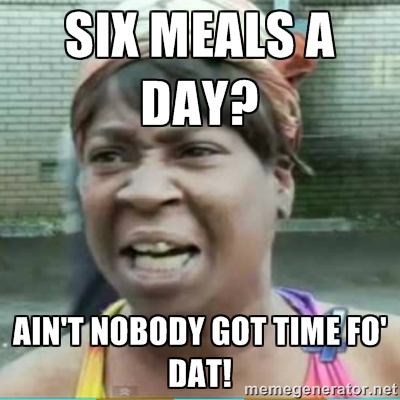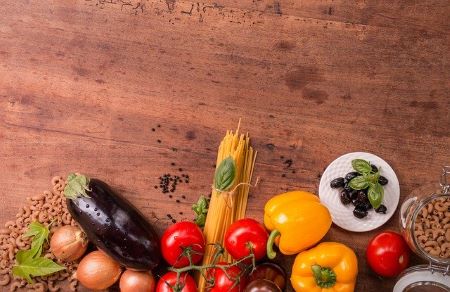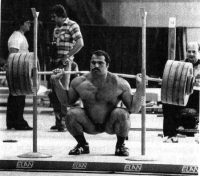Over the past 5 years, there has been a lot of debate on how often you should be eating to lose weight and improve your health. Research shows that it really comes down to what works for you.
If you want to eat breakfast, go ahead. If not, no worries. You can still lose weight and feel healthy.
If you want to eat six meals a day (bodybuilding diet), go right ahead. If it works for you and your lifestyle, awesome! But, that is not the only way, like we once thought. You can actually eat 1-2 large meals per day and still lose weight and feel great.
You don’t have to eat every 2-3 hours in order to keep your metabolism going like once believed. In fact, intermittent fasting may be a better way to increase the metabolism, and eating every 2-3 hours may decrease out metabolism by decreasing our insulin sensitivity.
If you want to learn more about intermittent fasting and meal frequency, I have plenty of research-based and practical knowledge on the topic on my blog.
After trying out multiple variations of intermittent fasting and bodybuilding diets with my clients and myself, I have come to a conclusion about meal frequency for the majority of the population.
Three meals a day seems to be the magic number when it comes to meal frequency. Let me explain.
Early in my career, I thought the only way to eat was like a bodybuilder. After all, it worked for me, why shouldn’t it work for everyone else? I found out quickly that the bodybuilding way of eating was just too difficult for people to maintain.
Unless you were a bodybuilder, or were extremely crazy about health and fitness, eating six meals a day was just not attainable. I was setting my clients up for failure, not because eating every three hours couldn’t work. It was more than that.
My clients failed because of the following:
- There was too much food to prepare and too much grocery shopping for them to maintain.
- They ended up eating too many calories.
- They would miss multiple feedings, making them feel like they were failing.
- They became hungrier throughout the day, and again, would eat too much.
- They would make poor food choices just to stick to the high-frequency meal plan.
- Because of the frequent eating, they became hungrier from increased ghrelin (hunger hormone). This would lead to grouchy people who missed meals and over-eaters when they did feed.
The majority of my clients would come back a few weeks later basically stating that the eating regimen I put them on was simply too hard to maintain. At first, I would chalk this up to laziness, but then, I sympathized. It was too hard. I personally grew frustrated with this type of eating. So, after many years of battling my clients to eat frequently, I explored other options.
Behold Intermittent Fasting
Over the past couple of years, I did a lot of research on intermittent fasting (IF). My own experiences with IF were life-changing! Yes, I really did have an epiphany when I first started IF. It totally changed the way I think and feel about eating. I experienced tremendous benefits from the various methods of IF, and had some of the best ever results with my clients.
But there were some missing pieces with IF. It worked for many, but not for all people. And I noticed that those who experienced the benefits of IF at first were not able to sustain the IF lifestyle.
I also noticed that some of my clients (and myself), had trouble getting in all of the proper nutrients that they needed to consume each day. Remember, one of the keys to health and fat loss is to reduce nutrient deficiencies.
Another reason I felt IF may be hard for people to always follow are the social barriers it imposes on people. Many of my clients have breakfast, lunch, and dinner meetings or other social events. Their biological clock has told them since birth to eat breakfast, lunch and dinner. Having three meals a day just seems to fit almost everyone’s lifestyle.
Also, intermittent fasting has so many variations that it became difficult to coach each person for the different variations. I was bombarded with questions on what to do and how people could take shortcuts when doing IF.
- Do I have to wait 16 hours before I eat when doing the LeanFast method, or can I just wait 12 hours?
- If I am doing the 20/4 Warrior Diet, can I eat just a little bit during my fast to get me through?
- Do I have to do IF every day, or just once in a while?
These were all valid questions that were debatable. As I noticed more and more of these types of questions popping up, I looked to see how I could develop a “base” type of eating plan, and compliment it with IF.
It came to the point where people wanted to find the easiest way to do IF, and in the end, it really wasn’t IF. It had become a three meal a day plan. But it worked! So, again, it made me think a little bit more about the Power of 3.
Before I continue, I want to give you a recap on some of the downfalls of IF.
- It only has a 25% success rate for women and an 85% success rate for men. It should be noted that women make up the majority of my clientele.
- People couldn’t get through the initial stages of hunger and would end up binging.
- People wanted to find the easiest way to do IF, wanted to create their own IF plan, and didn’t adhere to the actual protocol.
- They couldn’t sustain an IF lifestyle, long-term.
- People ran into social problems (breakfast, lunch, and dinner meetings).
- They were not getting in all of the proper nutrients.
Related: The Secret To Carb Cycling for Fat Loss
Again, I still feel there are amazing benefits when doing intermittent fasting. It works for a lot of people and I still practice it from time to time. Sometimes I will eat three times a day and sometimes I only eat twice a day. I might even eat four times a day on the weekend. But IF does not seem to work as eating base for most people.
So, I am going to show you the power of the three meals a day eating plan and how you can complement it with a fasting protocol on occasion.
The Power of 3-Meals a Day and Intermittent Fasting Combo
I am a huge fan of T-Nation.com. What they have done over the last ten years for fitness pros is amazing. It may be considered a meathead website, but you need to look past that. Some of the brightest minds in the industry are writing for them. So, in many cases, I turn to those pros for information. After all, meatheads want to burn fat, build muscle, and increase strength, just like the rest of the population!
Brad Schoenfeld wrote a great article on T-Nation about what meal plan worked the best, comparing three meals a day vs. six meals a day. After reading this multiple times, my mind was made up. For various reasons, three meals a day just made sense as the “base” eating protocol.
I was also very intrigued by T-Nation’s Editor, TC Luoma, in his article on the 5/2 Fat Loss Diet For Lifters. This article talks about how you can adhere to a normal eating schedule, say 3+ meals a day, for five days, and then perform a form of intermittent fasting on off-lifting days to help increase insulin sensitivity (one of the huge benefits of IF), and prime the body to burn fat and build muscle.
Both of these articles really got my brain spinning, and also gave me some great affirmation that I too, was onto something. It popped in my head that I now had the perfect combination of eating frequency for people to utilize every day, and then incorporating IF during certain periods of time would help reset the metabolism. It was my big “A-HA” moment!
The three meals a day eating protocol combined with the occasional fasting period could be implemented into almost anyone and everyone’s lifestyle. You didn’t have to be married to one type of eating protocol, and it left you with the flexibility to eat according to what worked for you at the current time.
You could allow yourself enough meal frequency to get all of your nutrients in, but not eat so much that you consumed too many calories, stimulated insulin too much, or got overly hungry and frustrated with missing meals.
Behold, the Power of 3/Intermittent IF Eating Protocol!
Related: Use The LeanFast Intermittent Fasting Program to get RIPPED!
How it Works
The outline of how to do the Power of 3/Intermittent IF Eating Protocol is actually quite simple.
- As your “base” eating protocol, you will eat three times a day. You will eat three meals a day about 90% of the time (roughly 6/7 days a week). This leaves room to miss a meal one day, and/or perform a fast when you overeat or are forced to make a poor food choice (explained later).
- I suggest you consume one super shake each day along with two other meals. It does not matter when you consume these meals. You just want to make sure that the foods you choose are nutrient-dense and the portion sizes match up with your body type and caloric needs.
- You will utilize intermittent fasting when you need to. IF is great to do after a day of overeating, done 16-20 hours before you plan to overeat, indulge in some not so healthy food, or when you are traveling and do not want to be forced to make poor food choices.
Yes, that’s it! It’s that simple. No magic tricks. Just consume a super shake each day, along with two other nutrient-dense meals that are portioned correctly for you. Perform a fast when you feel like it, or when needed. Or, you don’t even have to perform a fast, ever! That is totally up to you. Just know that a fast is always there, in case you need to cleanse the body and push the reset button after you have eaten not so healthy.
The main thing you need to do is eat three times a day for the majority of the time.
Meal Plan Templates
Over the years, I have written numerous meal plans for my clients. Most of the time they were either too hard to follow or they just didn’t fit a client’s lifestyle. The only people who could adhere to a very specific meal plan were my physique athletes (bodybuilders, figure, physique).
The problem with meal plans is that there are too many variables in life that will force you to go off the specific regimen that has been designed for that particular person. Time, money, business meetings, a family get together, long work schedules, vacations, and many other factors will cause you to go off your specific meal plan.
Instead of outlining meal plans with specific amounts of protein, carbohydrates, fats, and calories, I am going to give you some example templates. These templates will help guide you in the right direction as you continue your own journey to find out what works best for you.
The three meals a day plan will be the cornerstone of the meal plan templates. I will design these based around the time that you workout each day. I will also include when you should be taking some of the supplements that I mentioned earlier. The last couple of meal plans will include some of the intermittent fasting methods that I prefer.
Remember, these are just templates that will include broad food choices that are in the best and better categories of the Food Shelves, and rough portion estimates. The best way to determine what portions of each type of food (protein, carbohydrates, fats) is to refer to the Food Composition and Macronutrient Breakdown For You and Your Goals section of the book.
Meal Plan Template #1 – 3 Meals A Day When Working Out In The Morning
Pre-workout:
2 scoops of branched-chain amino acids with 16-24 ounces of water, or, 250-40 grams of whey protein. (SFH or Progenex) No need for carbs here, since your glycogen storage is good to go in the morning.
Meal One/Post-Workout
Super shake (choose a protein, fat, fruit, green food, and blend it with ice and water). If you want to see more on how to make super shakes, you can check out my blog here.
You could also follow the protocols in the Workout Nutrition section in the book.
Meal Two:
1-2 palms of protein (organic chicken, grass-fed beef, organic eggs, etc.)
0.5-2 cupped handfuls of carbohydrates (sweet potatoes, jasmine rice, quinoa)
1-2 fistfuls of vegetables (broccoli, asparagus, leafy greens, peppers, cruciferous veggies)
1-2 thumbs of fat (extra virgin olive oil, almonds, avocados)
Meal Three:
1-2 palms of protein (organic chicken, grass-fed beef, organic eggs, etc.)
0.5-2 cupped handfuls of carbohydrates (sweet potatoes, jasmine rice, quinoa)
1-2 fistfuls of vegetables (broccoli, asparagus, leafy greens, peppers, cruciferous veggies)
1-2 thumbs of fat (extra virgin olive oil, almonds, avocados, grass-fed butter)
Meal Plan Template #2 – 3 Meals A Day When Working Out In The Afternoon
Meal One:
Super shake (choose a protein, fat, fruit, green food, and blend it with ice and water). If you want to see more on how to make super shakes, you can check out my blog here.
Or,
1-2 palms of protein (organic eggs, grass-fed whey protein)
0.5-2 cupped handfuls of carbohydrates (steel cut or rolled oats, berries or other fruit)
1-2 fistfuls of vegetables if you have eggs (broccoli, asparagus, leafy greens, peppers, cruciferous veggies)
1-2 thumbs of fat (nuts and seeds, extra virgin coconut oil, grass-fed butter)
Pre-Workout:
2 scoops of branched-chain amino acids with 16-24 ounces of water, or 20-40 grams of whey protein. For added muscle gains, include carbohydrate protocol in Workout Nutrition section of the book.
Meal Two/Post-Workout
Super Shake (choose a protein, fat, fruit, green food, and blend it with ice and water). If you want to see more on how to make super shakes, you can check out my blog here.
You could also follow the protocols in the Workout Nutrition section in the book.
Meal Three:
1-2 palms of protein (organic chicken, grass-fed beef, organic eggs, etc.)
0.5-2 cupped handfuls of carbohydrates (sweet potatoes, jasmine rice, quinoa)
1-2 fistfuls of vegetables (broccoli, asparagus, leafy greens, peppers, cruciferous veggies)
1-2 thumbs of fat (extra virgin olive oil, almonds, avocados)
Meal Plan Template #3 – 3 Meals A Day When Working Out In The Evening/Night-Time
Meal One:
Super shake (choose a protein, fat, fruit, green food, and blend it with ice and water).
Or,
1-2 palms of protein (organic eggs, grass-fed whey protein)
0.5-2 cupped handfuls of carbohydrates (steel cut or rolled oats, berries or other fruit)
1-2 fistfuls of vegetables if you have eggs (broccoli, asparagus, leafy greens, peppers, cruciferous veggies)
1-2 thumbs of fat (nuts and seeds, extra virgin coconut oil, grass-fed butter)
Meal Two:
1-2 palms of protein (organic chicken, grass-fed beef, organic eggs, etc.)
0.5-2 cupped handfuls of carbohydrates (sweet potatoes, jasmine rice, quinoa)
1-2 fistfuls of vegetables (broccoli, asparagus, leafy greens, peppers, cruciferous veggies)
1-2 thumbs of fat (extra virgin olive oil, almonds, avocados, grass-fed butter)
Pre-Workout
2 scoops of branched-chain amino acids with 16-24 ounces of water, or 20-40 grams of whey protein. For added muscle gains, include carbohydrate protocol in Workout Nutrition section of the book.
Meal Three/Post Workout
Super shake (choose a protein, fat, fruit, green food, and blend it with ice and water). If you want to see more on how to make super shakes, you can check out my blog here.
You could also follow the protocols in the Workout Nutrition section in the book.
Related: The Keto Diet: A Beginner’s Guide
Meal Plan Template #4 – Leangains By Martin Berkhan
(16h fast / 8h feed)
This brand of fasting is based on an 8-hour feeding period followed by a 16 hour fast. However, it also layers a few other food rules on top. The diet should be high in protein, should cycle carbohydrates, should include fasted training, and should use nutrient timing (eating the bulk of your calories during the post-exercise period). On this plan, you fast from, say, 9 PM on Monday night until 1 PM on Tuesday afternoon. If you were going to exercise, you would do so just before 1 PM on Tuesday, with 10g BCAAs (branched-chain amino acids) during training. After training, you eat 2-3 meals before 9 PM, with your biggest meal coming right after exercise. The fast begins again on Tuesday evening until Wednesday at 1 PM, and repeats every day.
Most people usually will eat two meals during the eight-hour feed. The same rules apply to these meals. I suggest picking two of the meals below.
#1
1-2 palms of protein (organic chicken, grass-fed beef, organic eggs, etc.)
0.5-2 cupped handfuls of carbohydrates (sweet potatoes, jasmine rice, quinoa)
1-2 fistfuls of vegetables (broccoli, asparagus, leafy greens, peppers, cruciferous veggies)
1-2 thumbs of fat (extra virgin olive oil, almonds, avocados, grass-fed butter)
#2
1-2 palms of protein (organic eggs, grass-fed whey protein)
0.5-2 cupped handfuls of carbohydrates (steel cut or rolled oats, berries or other fruit)
1-2 fistfuls of vegetables if you have eggs (broccoli, asparagus, leafy greens, peppers, cruciferous veggies)
1-2 thumbs of fat (nuts and seeds, extra virgin coconut oil, grass-fed butter)
#3
Super shake (choose a protein, fat, fruit, green food, and blend it with ice and water). If you want to see more on how to make super shakes, you can check out my blog here.
Note: If you do get hungry during the fasting period, and are looking to build muscle, or have a high activity level (example, CrossFit, Olympic Lifting, 4+ day a week athlete), then you can have 20-40 grams of whey protein.
Meal Plan Template #5 – Warrior Diet by Ori Hofmekler
(20 hour fast /4-hour feed)
On this plan, you fast for 20 hours each day, working out during your fasted state. Then, eat your daily food intake within the 4-hour feeding window. After that 4-hour feeding period, fast again for 20 hours. Generally, most people place their 4-hour feeding window at the end of the day, as it’s more convenient for family dinners and after-work training sessions. However, the 20 hours of fasting and four hours of feeding can occur at any time during the day.
I suggest taking 5-10 grams of BCAA, or, 20-40 grams of whey protein before and after a workout, during the fasted state.
For the eating window, most people get one large meal, and some will have two smaller meals. It just depends. If you eat only once, I would bump up the portion sizes. Take a look.
1-3 palms of protein (organic chicken, grass-fed beef, organic eggs, etc.)
1-3 cupped handfuls of carbohydrates (sweet potatoes, jasmine rice, quinoa)
2-4 fistfuls of vegetables (broccoli, asparagus, leafy greens, peppers, cruciferous veggies)
1-4 thumbs of fat (extra virgin olive oil, almonds, avocados, grass-fed butter)
If you eat twice during the 4-hour eating period, stick to regular portion sizes.
The Choice Is Yours
In the end, how you eat is totally up to you. Everyone’s body, activity level and schedule are a little different. This means you need to find what works for YOU! This protocol is simply a suggestion and is just something for you to think about, explore and see if it works for you. As long as you are drinking enough water, getting a lot of sleep, eating lots of veggies and adequate protein, fat, and carbohydrates, meal frequency will not matter as much. Find an eating schedule that works for you and stay consistent.

Justin Grinnell is a highly respected Certified Strength and Conditioning Specialist (CSCS), Certified Personal Trainer (CPT), and CrossFit Level 1 Trainer with over a decade of experience helping clients achieve peak performance. He is the founder and owner of State of Fitness in East Lansing, Michigan — a premier training facility recognized as one of the leading fitness centers in the Midwest.
Since opening its doors just four years ago, State of Fitness has grown to over 450 active members, each benefiting from Justin’s proven training systems, science-based programming, and hands-on leadership. His expertise spans athletic performance, strength development, body composition, and functional training, making him a sought-after coach for both everyday clients and competitive athletes.
Justin is also an established voice in the fitness industry. For more than ten years, he has been a featured writer for Healthy & Fit magazine and currently contributes to Muscle & Fitness, one of the most recognized publications in the industry. Through his blog, GrinnellTraining.com, he shares actionable training tips, nutritional strategies, and expert insights with a global audience.










